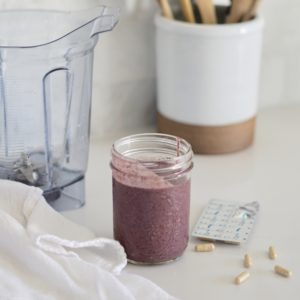03 May love your guts part 2
 Now that you understand the basics about probiotics and your microbiome “neighborhood” – let’s dive into the rest. For Part 2 we’ll discuss how to integrate prebiotics and probiotics into your routine.
Now that you understand the basics about probiotics and your microbiome “neighborhood” – let’s dive into the rest. For Part 2 we’ll discuss how to integrate prebiotics and probiotics into your routine.
getting started
I always recommend using food sources first. There are many natural prebiotic and probiotic food sources. For a list, check out my prior post.
Why? First of all, supplements cannot replace the complex nature of foods. We don’t fully understand how it all works in the body. The unique combination of vitamins, minerals, phytonutrients, fiber and bacteria in food simply cannot be replicated in a pill. Secondly, before you purchase a probiotic product, it’s best to test your body’s response with food sources to determine how your body responds. Plus, it’s easy to modify the amount based on tolerance and it’s less expensive.
daily is the key
Eating sources of natural probiotics and prebiotics daily is ideal. Start with 1 tbsp (as tolerated) of probiotic foods per day. Diversity is also important for your neighborhood – more on that in a bit. So, mixing it up and eating a variety of foods is important. Studies have shown shifts in the microbiome in as few as 2 to 3 days! For major shifts to take place, it can take longer. However, many people can feel an improvement in symptoms within a few weeks.
that’s not all
“About 75% of the food in the Western diet is of limited or no benefit to the microbiota in the lower gut.”1 In order to really help the neighborhood thrive, reducing the bad stuff is as important as adding the good stuff. Public enemy #1 to your neighborhood: sugar & refined carbohydrates.
You don’t need to go cold-turkey here. Focus your attention to what you want to add rather than what you are avoiding. I love the quote, “where attention goes, energy flows.” It’s true with food too! Therefore, at each meal think about how you can add more real food: fruits, vegetables, greens, nuts, seeds, whole grains, and legumes (beans).
Also, when consuming meat or dairy products, always choose organic, pasture-raised, or wild caught fish. Most non-organic meat and dairy products come from animals treated with antibiotics. When improving the microbiome neighborhood, consuming trace amounts of antibiotics won’t help. It is important to be mindful about where your food comes from. This will go a long way to improve your overall health.
supplements

Now, I know not everyone loves fermented foods or eats them every day. In that case, supplements have you covered. There is not one “right” solution for everyone (since we all have different neighborhoods), but let’s cover the basics.
- Safety first. Probiotics are safe for most people, but talk to a health professional first if you are currently experiencing symptoms, suffer from a serious underlying illness, have an immune disorder, or before giving to an infant. In some cases, adding probiotics or prebiotics may increase discomfort until other underlying causes are addressed.
- Know why you’re taking probiotics. Is it following a round of antibiotics to prevent diarrhea, for immune support, to improve digestion, to support detoxification, or to reduce bloating? This is important to understand and will help you choose the probiotic that’s right for you.
- Diversity is important. Research is showing that different probiotic strains accomplish different things in the body. Strains can be antimicrobial, reduce inflammation, help heal the digestive tract, or strengthen your natural immune system response. Seriously amazing! For overall health, finding a probiotic with multiple strains can be very beneficial.
- Consider your lifestyle.
- Do you travel often? Many probiotics require refrigeration, a shelf-stable probiotic may be a better choice.
- Do you eat many prebiotic sources naturally? If not, you may want to choose a synbiotic (containing both probiotics & prebiotics) or add a prebiotic supplement.
- Are you sensitive to dairy? Always check allergen information since many probiotics are grown using a dairy source. Also, it’s important to know that probiotics can help with lactose digestion! You may find yourself less sensitive once you begin a routine!
recommendations
Everyone has a unique neighborhood, and therefore needs an individual approach. As a result, I have shared some of the most common supplements that we use with clients. If you are interested in any of the professional products mentioned below, use this link to receive a 5% discount!
Adults
- Lactoprime Plus by Klaire Labs Professional brand, high-potency for treatment, multi-strain, well-researched, and requires refrigeration. No prebiotics included. Free of all common allergens, including wheat & dairy.
- Megaflora Plus Multi-strain, high potency for treatment, and requires refrigeration. No prebiotics included. Gluten, soy, & dairy free.
- JarroDophilus Multi-strain, ideal for prevention, requires refrigeration. Free of common allergens, including wheat & dairy.
- JarrowDophilus EPS Multi-strain, ideal for prevention, shelf-stable, no refrigeration. Contains dairy.
Children
Please note these products are recommended for children ages 3 and over.
- Ther-biotic Children’s Chewable Professional brand, high-potency, and multi-strain. No prebiotics included. Free of common allergens.
- MetaKids Chewable Probiotic Professional brand, ideal for prevention, two-strains, well-researched, and requires refrigeration. No prebiotics included. Free of common allergens.
- BioGaia Single strain, ideal for prevention, well-researched, and is shelf-stable (no refrigeration). No prebiotics included. Free of common allergens.
Please keep in mind that where you purchase supplements, especially probiotics which require refrigeration matters! I have included links above to dedicated distributors that understand how to store and send these products to guarantee potency and quality. I would strongly advise against purchasing probiotics from Amazon.
Finally, please message me with questions, comments, or ideas for a future post. I hope this month’s blog has helped you learn how to love your guts.



